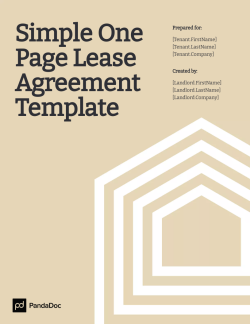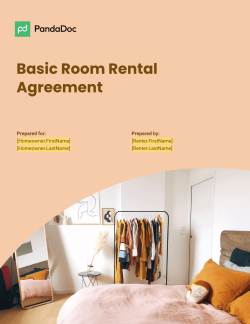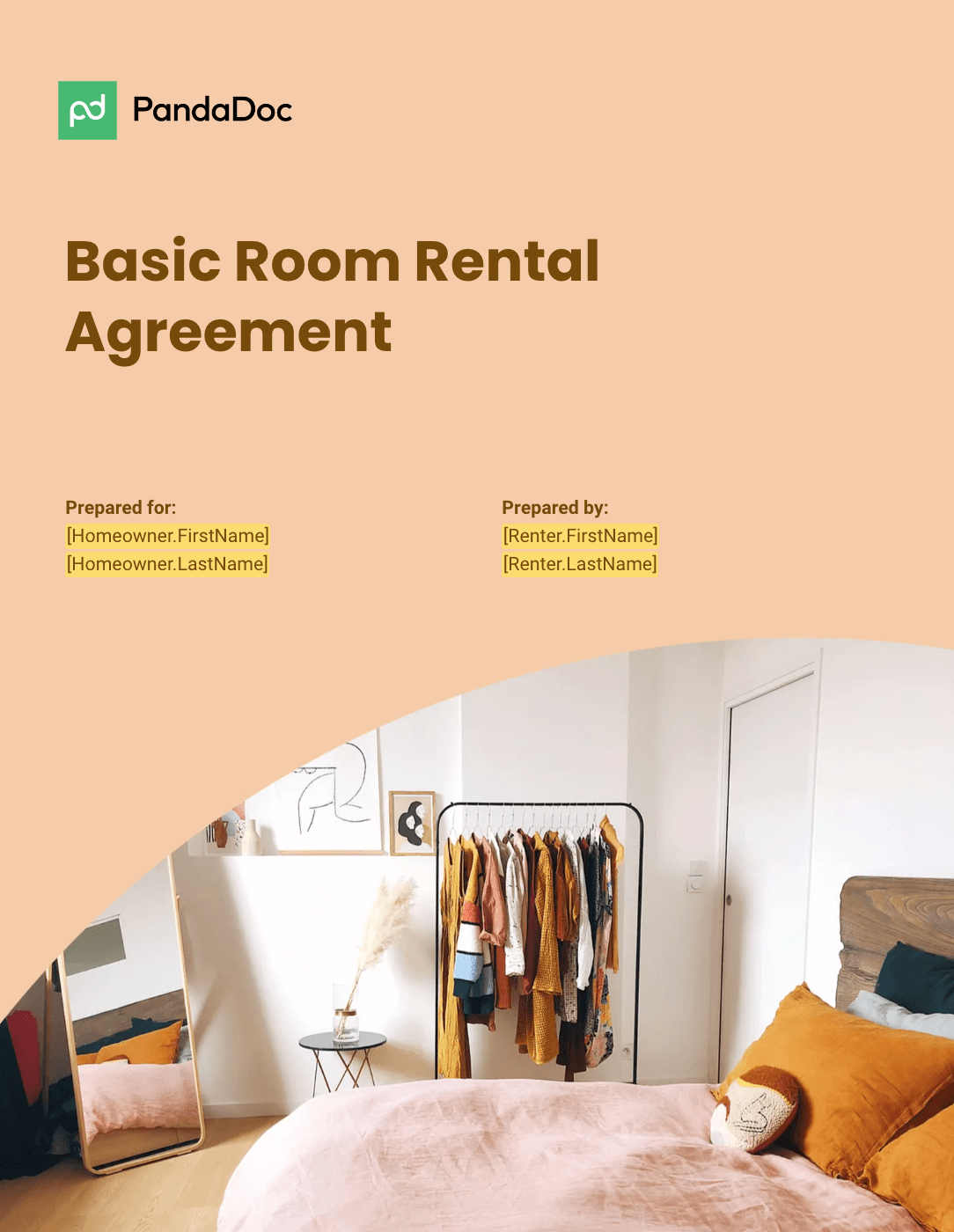What is a Room Rental Agreement?
Room rental agreements are a specialized lease contract that binds a landlord and tenant. These agreements have specifically been created to govern situations where the tenant only leases a room within the property. As such, the landlord and tenant must understand and agree to their responsibilities within this contract.
By Types
Room rental agreements can vary based on several different situations. Let’s take a quick look at three of the most commonly used room rental agreements:
One-page
This simple room agreement contains just the basic requirements of a room agreement to make the process easier. This type of contract is best used in familiar situations where the agreement doesn’t require too many terms and conditions.

Simple One Page Lease Agreement Template
Used 5,020 times
Is it necessary to establish a legal agreement between a landlord and tenant? Use this Simple One Page Lease Agreement Template for your requirements by downloading it.
Standard
A standard room rental agreement contains all of the required clauses as well as a few additional ones to cover any possible outcome related to the contract. This agreement is best used in situations where you’re unfamiliar with the tenant or rental process, as it offers more clarity and protection to both parties.

Room Rental Agreement Template
Used 5,724 times
Utilize this basic room rental agreement on your next room rental to ensure all your rights as a tenant and landlord are covered by the legal laws in your state.
Month-to-month
As the name suggests, a month-to-month room rental contract is used for short-term leases. These are best used in situations where you don’t want to be burdened by a long-term lease or if you’re in an area where rental prices are volatile and fluctuate frequently.
By State
Room rental agreements in the US are each governed by their own state. As such, different states might have other requirements that need to appear on the contract. Ensure you include all required information based on your location using a state-specific template.
- Alabama
- Alaska
- Arizona
- Arkansas
- California
- Colorado
- Connecticut
- Delaware
- Florida
- Georgia
- Hawaii
- Idaho
- Illinois
- Indiana
- Iowa
- Kansas
- Kentucky
- Louisiana
- Maine
- Maryland
- Massachusetts
- Michigan
- Minnesota
- Mississippi
- Missouri
- Montana
- Nebraska
- Nevada
- New Hampshire
- New Jersey
- New Mexico
- New York
- North Carolina
- North Dakota
- Ohio
- Oklahoma
- Oregon
- Pennsylvania
- Rhode Island
- South Carolina
- South Dakota
- Tennessee
- Texas
- Utah
- Vermont
- Virginia
- Washington
- West Virginia
- Wisconsin
- Wyoming
Creating Your Room Rental Agreement with PandaDoc
Embarking on creating a rental agreement can seem like navigating through a labyrinth of legalities and specifics. It’s a task often fraught with complexity and the pressure of getting every detail right. Enter PandaDoc: your digital ally in demystifying this process. With a diverse collection of room rental agreement templates, you’re streamlining the process and ensuring a comprehensive and protective contract for all parties involved.
Join us in this step-by-step guide where we unveil how to customize these templates, transforming them into perfect fits for your unique rental situations. It’s more than just filling in the blanks; it’s about crafting a secure and harmonious rental experience.
- Personalizing Party Details: Start by adding a personal touch. Include the names of the landlord and tenant and a brief introduction or background, fostering a sense of familiarity and trust.
- Describing the Property: Turn the property details section into a narrative, highlighting unique features of the room or apartment and the neighborhood’s character.
- Clarifying the Rental Period: Discuss the flexibility or rigidity of the lease terms. Highlighting the potential for renewal or seasonal variations can make this section more dynamic.
- Detailing Rental Payments: Go beyond mere figures. Explain the reasoning behind the cost, compare it with market rates, and perhaps provide examples of what the rent covers, making it more relatable.
- Security Deposits and Additional Fees: This section can be more engaging by explaining the purpose of these fees, how they’re utilized, and under what circumstances they’re refundable.
- Defining Roles and Responsibilities: Turn this part into a guide on cohabitation harmony. Explain how each responsibility contributes to a peaceful living environment.
- Finalizing the Agreement: Emphasize the significance of signing the agreement, perhaps with a note on the importance of legal documentation in safeguarding rights and responsibilities.
By infusing each section with context, comparisons, and a narrative style, filling out a room rental agreement becomes an informative and engaging journey for both parties.
Key Components and Terms
All room rental agreements need to include a few basic elements. You can add more if your needs or state require it, but the basic terms that must be featured include the following:
- Information of all parties
- Property address and details
- Room description
- Rental term
- Rent amount and due date
- Late fees
- Utility costs
- House rules
- Household chores (if applicable)
- Notice period to terminate
- List of any included furniture or amenities
- Tenant’s insurance (if applicable)
- Signature and signed date of all parties
Importance of a Written Room Rental Agreement
Having a written room rental agreement in place is essential. While verbal agreements can be enforced, these are difficult to prove and, therefore, often lead to misunderstandings. Having a well-crafted written contract will help eliminate any miscommunications and potential disagreements. Let’s take a closer look at why these agreements and specific elements are so important.
Parties Involved and Property Details
Legally binding agreements include the details of the parties entering into the contract and details on the property. This information is crucial to include should legal proceedings need to be taken. If either party’s details aren’t included, they cannot be held to the terms outlined in the agreement.
Rent and Payment Terms
The rent and payment terms are crucial to include in your agreement. Not only does this clarify how much the tenant needs to pay and when, but it also protects both parties in the case of non-payment or late payments.
Security Deposit and Other Fees
A room rental agreement outlines all fees associated with the agreement apart from the rent. This includes fees related to the security deposit, utilities, pet deposits, and more. Getting this information in writing will ensure that both parties agree to all fees involved in the lease.
Duration of the Rental
Getting the duration of the rental in writing is crucial to ensure both parties honor the contract. Without getting this in writing, you’ll be forced to follow state laws regarding eviction, termination, and contract extension. This could introduce a lot of uncertainty to the lease for both parties.
Maintenance and Repairs
Outlining maintenance and repairs in your contract is essential. Not only does this help to protect the owner’s investment, but it also clarifies who’s responsible for what type of repairs or maintenance to avoid any issues down the line.
House Rules and Responsibilities
Including the house rules and responsibilities in writing in your contract is important to foster a good relationship. Room rental agreements usually mean that there are other people within the same property along with shared communal spaces such as living areas and bathrooms. In this case, each person needs to understand the house rules and the division of chores or responsibilities.
Disclosures
Real estate and rental laws can vary by jurisdiction, and the specific requirements for disclosures in a room rental agreement can differ from state to state. Here are the most common disclosures that may be required or recommended in a room rental agreement:
- Lead-Based Paint Disclosure: Federal law requires disclosure of known lead-based paint and lead-based paint hazards for properties built before 1978.
- Bedbug Disclosure: Some states and localities require landlords to disclose information about bedbug infestations.
- Mold Disclosure: Certain states may require disclosure of information about mold in the rental property.
- Radon Gas Disclosure: In areas where radon gas is a concern, landlords may be required to disclose information about radon levels in the property.
- Megans Law Disclosure: Some states require landlords to disclose information about registered sex offenders in the area.
- Rent Control or Rent Stabilization Notices: In locations with rent control or rent stabilization laws, landlords may need to provide information about these regulations.
- Tenant Rights Information: Some states require landlords to provide tenants with information about their rights and responsibilities.
Compliance with Landlord-Tenant Laws
Despite the variations across different states, there are a number of obligations for landlords and tenants that are general and universal. When it comes to the duties of landlords, most states require the following:
- Standards of habitability: Landlords are responsible for ensuring that the property is structurally safe, free from pests, and free from any environmental hazards such as mold or other toxins.
- Reasonable steps to ensure quiet enjoyment: The landlord must take the necessary steps, such as introducing house rules, to ensure that tenants don’t make noise that can affect the other tenant’s quiet enjoyment of the property.
- Reasonable safety measurements: Landlords must provide the required safety equipment as required by the state. These can include fire detectors, carbon monoxide detectors, and other safety equipment.
- Reasonable maintenance and repairs: Landlords are required to make reasonable repairs and maintenance to ensure the property remains in a safe state.
- Monitoring the condition of the premises: The landlord should also monitor the condition of the premises. This is to ensure that any issues are addressed in a timely manner to prevent extensive damage.
However, the landlord isn’t the only party with specific responsibilities as required by most states. Tenants also have the following duties as per the landlord-tenant act:
- Reasonable wear and tear: The tenant is responsible for preventing damages beyond normal wear and tear. Malicious or accidental damages can lead to a loss of the tenant’s security deposit and might even lead to early termination or eviction.
- Reasonable cleanliness: The tenant is expected to keep the property reasonably clean for the duration of the agreement.
- Communication with the landlord: The tenant is also responsible for notifying the landlord of any issues or repairs that must be done promptly.


